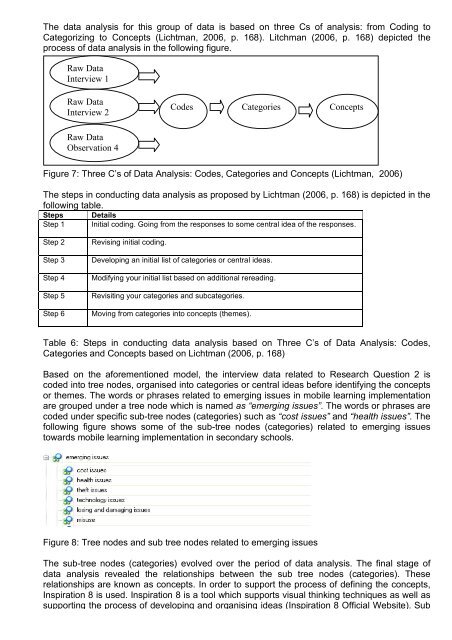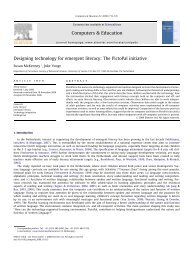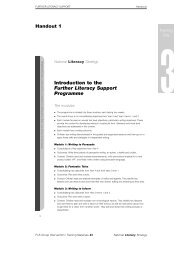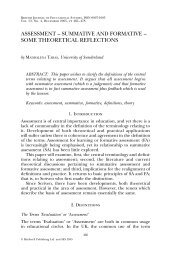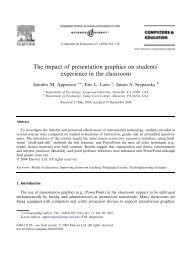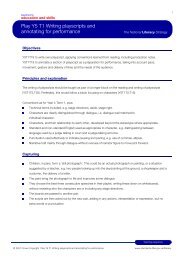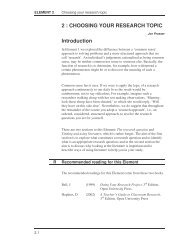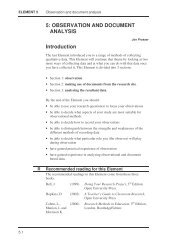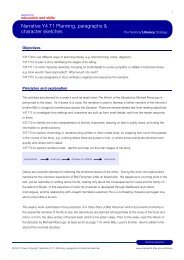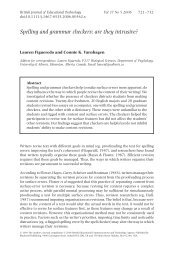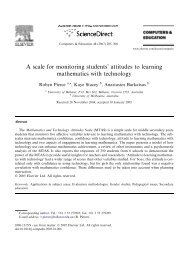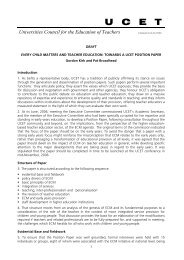from Coding to Categorizing to Concepts (Lichtman, 20 - PGCE
from Coding to Categorizing to Concepts (Lichtman, 20 - PGCE
from Coding to Categorizing to Concepts (Lichtman, 20 - PGCE
You also want an ePaper? Increase the reach of your titles
YUMPU automatically turns print PDFs into web optimized ePapers that Google loves.
The data analysis for this group of data is based on three Cs of analysis: <strong>from</strong> <strong>Coding</strong> <strong>to</strong><br />
<strong>Categorizing</strong> <strong>to</strong> <strong>Concepts</strong> (<strong>Lichtman</strong>, <strong>20</strong>06, p. 168). Litchman (<strong>20</strong>06, p. 168) depicted the<br />
process of data analysis in the following figure.<br />
Raw Data<br />
Interview 1<br />
Raw Data<br />
Interview Figure 2 ??<br />
Codes Categories <strong>Concepts</strong><br />
Raw Data<br />
Observation 4<br />
Figure 7: Three C’s of Data Analysis: Codes, Categories and <strong>Concepts</strong> (<strong>Lichtman</strong>, <strong>20</strong>06)<br />
The steps in conducting data analysis as proposed by <strong>Lichtman</strong> (<strong>20</strong>06, p. 168) is depicted in the<br />
following table.<br />
Steps<br />
Step 1<br />
Details<br />
Initial coding. Going <strong>from</strong> the responses <strong>to</strong> some central idea of the responses.<br />
Step 2<br />
Step 3<br />
Step 4<br />
Step 5<br />
Step 6<br />
Revising initial coding.<br />
Developing an initial list of categories or central ideas.<br />
Modifying your initial list based on additional rereading.<br />
Revisiting your categories and subcategories.<br />
Moving <strong>from</strong> categories in<strong>to</strong> concepts (themes).<br />
Table 6: Steps in conducting data analysis based on Three C’s of Data Analysis: Codes,<br />
Categories and <strong>Concepts</strong> based on <strong>Lichtman</strong> (<strong>20</strong>06, p. 168)<br />
Based on the aforementioned model, the interview data related <strong>to</strong> Research Question 2 is<br />
coded in<strong>to</strong> tree nodes, organised in<strong>to</strong> categories or central ideas before identifying the concepts<br />
or themes. The words or phrases related <strong>to</strong> emerging issues in mobile learning implementation<br />
are grouped under a tree node which is named as “emerging issues”. The words or phrases are<br />
coded under specific sub-tree nodes (categories) such as “cost issues” and “health issues”. The<br />
following figure shows some of the sub-tree nodes (categories) related <strong>to</strong> emerging issues<br />
<strong>to</strong>wards mobile learning implementation in secondary schools.<br />
Figure 8: Tree nodes and sub tree nodes related <strong>to</strong> emerging issues<br />
The sub-tree nodes (categories) evolved over the period of data analysis. The final stage of<br />
data analysis revealed the relationships between the sub tree nodes (categories). These<br />
relationships are known as concepts. In order <strong>to</strong> support the process of defining the concepts,<br />
Inspiration 8 is used. Inspiration 8 is a <strong>to</strong>ol which supports visual thinking techniques as well as<br />
supporting the process of developing and organising ideas (Inspiration 8 Official Website). Sub
tree nodes (categories) are represented in Inspiration 8 with symbols used the same name as in<br />
Nvivo. For example, the sub-tree node (categories) known as “cost issue” in Nvivo is also<br />
named as “cost issue” in Inspiration 8.<br />
All sub-tree nodes (categories) are arranged and re-arranged in Inspiration 8 until a pattern of<br />
concepts emerged.<br />
<strong>Lichtman</strong>, M. (<strong>20</strong>06) Qualitative Research in Education: A User’s Guide. California: Sage<br />
Publications


